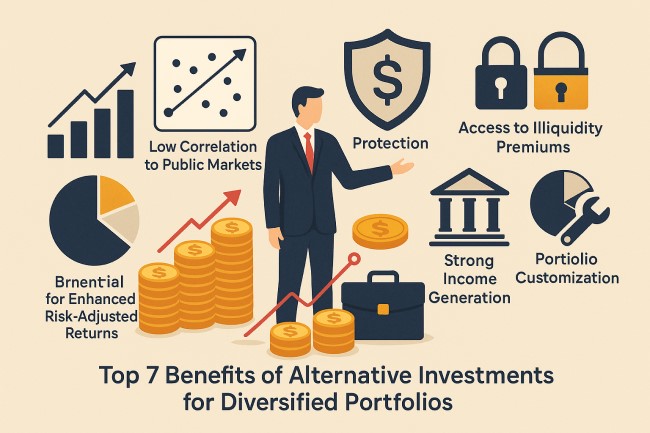Top 7 Benefits of Alternative Investments for Diversified Portfolios

Public markets are becoming increasingly volatile and unpredictable, prompting investors to explore smarter ways to manage risk and achieve stable returns. One strategy that continues to gain momentum is the inclusion of alternative investments in diversified portfolios. These investments, ranging from private credit and real estate to infrastructure and hedge funds, offer exposure to asset classes that don’t always move in sync with traditional stocks and bonds.
While this concept isn’t new, the relevance of the best alternative investments is more important today than ever. With benefits like risk mitigation, income generation, and long-term capital appreciation, they’ve become a critical tool for building resilient portfolios. Let’s explore the top seven benefits of alternative investments and why they are increasingly being seen as the best bet for enhancing portfolio performance.
The Key Advantages of Adding Alternatives to Your Portfolio
The following are some key benefits of incorporating alternative investments into your portfolio.
-
True Diversification Beyond Traditional Assets
One of the most compelling benefits of alternative investments is their ability to diversify beyond the classic equity and bond mix. Unlike traditional markets that often move in tandem during periods of economic stress, alternatives tend to follow different return drivers.
For instance, real estate may thrive on rental demand, while private credit can offer stability through structured debt terms. By spreading exposure across various asset classes, portfolios are less likely to be dragged down by a single market event. This form of diversification is critical for maintaining long-term resilience and smoothing out returns across market cycles.
-
Low Correlation to Public Markets
Alternative investments generally exhibit a low or even negative correlation to public equities and bonds. This means that during times when traditional markets are underperforming, alternatives may still deliver positive results or at least help cushion the impact.
Take private credit, for example. It is not directly impacted by daily stock market swings, making it a solid hedge against volatility. Similarly, infrastructure investments often rely on long-term contracts or government support, which keeps returns more stable.
The best alternative investments are those that help reduce overall portfolio volatility while preserving growth potential.
-
Potential for Enhanced Risk-Adjusted Returns
Many investors are not just seeking high returns—they want better returns for the level of risk they are willing to take. This is where alternative investments often shine. Because they tap into markets that are less efficient or harder to access, they offer a chance for alpha—the ability to outperform standard benchmarks.
Private equity, for instance, allows access to companies before they go public, offering opportunities for value creation. Hedge funds can employ sophisticated strategies to manage risk while targeting positive returns regardless of market direction.
When used wisely, the best alternative investments can improve a portfolio’s Sharpe ratio, which measures returns relative to risk.
-
Access to Illiquidity Premiums
Illiquidity is often viewed as a disadvantage, but in the world of alternative investments, it can actually be a source of higher returns. This is known as the “illiquidity premium”—extra compensation investors receive for locking up their capital for longer periods.
Real assets, such as commercial real estate or infrastructure projects, are not traded on public exchanges; however, they can offer stable and predictable cash flows over time. Private credit funds often structure long-term debt agreements that provide consistent interest payments, typically at higher rates than public bonds.
By accepting a certain level of illiquidity, investors can unlock a valuable source of incremental returns that are often absent in liquid, public markets.
-
Strong Income Generation Potential
With interest rates remaining low and dividend payouts often unpredictable, alternative investments offer a compelling way to generate steady income. Real estate investments, particularly those focused on rental properties or commercial leases, offer a steady stream of cash flow. Similarly, private credit vehicles pay out interest income on a fixed schedule.
Some of the best alternative investments—such as infrastructure debt or business development companies (BDCs)—are specifically structured for income, making them a strategic addition for those looking to match liabilities or fund near-term obligations.
The consistent income potential from alternatives can be a critical component of an investment strategy focused on total return.
-
Protection Against Inflation
Inflation erodes purchasing power, and traditional fixed-income securities often struggle to keep up. Fortunately, certain alternative investments are naturally aligned with inflationary environments.
For instance, infrastructure assets like toll roads, utilities, and energy pipelines often have built-in inflation-adjusted pricing mechanisms. Real estate can also benefit from rising prices and increased rental income over time.
By allocating to assets with tangible value and inflation-linked returns, investors can protect their portfolios from the silent threat of inflation. It’s no surprise that many are now turning to the best alternative investments to hedge against this growing risk.
-
Greater Portfolio Customization and Control
Traditional mutual funds and ETFs offer limited flexibility in terms of structure and exposure. In contrast, alternative investments can be tailored to meet specific investment goals.
Want more income? Focus on private debt and real estate income trusts. Need long-term growth? Explore private equity or venture capital. Concerned about downside risk? Hedge funds and absolute return strategies can be positioned accordingly.
This ability to build highly personalized portfolios is a major advantage of alternatives. They allow investors to align capital with strategic outcomes more precisely—something that’s becoming increasingly important in today’s complex financial environment.
Rethinking What It Means to Diversify
Alternative investments are quickly becoming a core part of smart portfolio building, not just a nice-to-have. With markets moving unpredictably, inflation persisting, and traditional assets offering limited upside, investors are increasingly seeking alternative sources of stability and growth.
From private credit, which generates steady income, to real estate and infrastructure that help hedge against inflation, the value of these non-traditional assets is clearer than ever. Adding the best alternative investments into the mix can help reduce risk, unlock new return streams, and bring more balance to the overall portfolio.
And for those looking to explore opportunities beyond public markets, whether in real estate, credit, or even newer asset classes, platforms like rootMoney make private deals more accessible, making that journey a lot smoother for qualified investors. It’s about time alternative investing became less of a mystery and more of a strategy.

